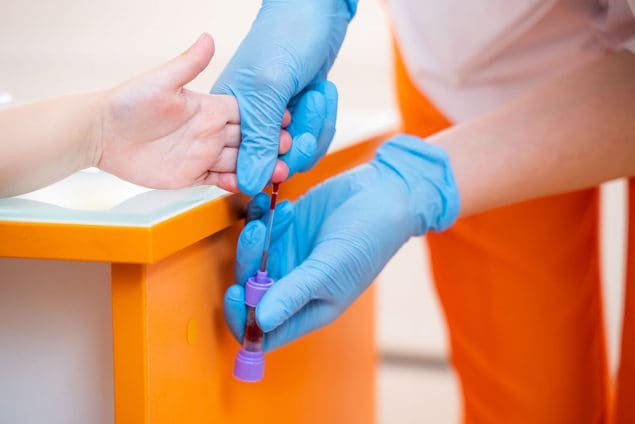Blood Lead Levels in Children
CDC recommends testing blood for lead exposure. There are often no apparent symptoms when a child is exposed to lead. Because of this, a blood test is the best way to determine if a child has been exposed to lead. If your child may have been exposed to lead, talk to your healthcare provider about getting a blood lead test. Based on your child’s blood lead test results, healthcare providers can recommend follow-up actions and care.

During a blood lead test, a small amount of blood is taken from the finger, heel, or arm and tested for lead. Two types of blood tests may be used.
- A finger-prick or heel-prick (capillary) test is usually the first step to determine if a child has lead in their blood. While finger-prick tests can provide fast results, they also can produce higher results if lead on the skin is captured in the sample. For this reason, a finger-prick test that shows a blood lead level at or above the CDC’s blood lead reference value is usually followed by a second test to confirm.
- A venous blood draw takes blood from the child’s vein. This type of test can take a few days to receive results and is often used to confirm blood lead levels seen in the first capillary test.
Both capillary and venous samples can be analyzed using higher complexity methods such as such as inductively coupled plasma mass spectrometry (ICP-MS) or graphite furnace atomic absorption spectroscopy (GFAAS). However, venous samples are more reliable at identifying lower blood lead levels than capillary samples when analyzed using higher complexity methods (i.e., ICP-MS and GFAAS).
Most children with any lead in their blood have no obvious immediate symptoms. If a child may have been exposed to lead, parents should talk to their child’s health care provider about getting a blood lead test. Healthcare providers and most local health departments can test for lead in the blood. Many private insurance policies cover the cost of testing for lead in the blood. The cost of blood lead testing for children enrolled in Medicaid is covered by the Centers for Medicare & Medicaid services.
If a child has lead in their blood above the CDC blood lead reference value, their doctor may recommend follow-up services. These include finding and removing lead from the child’s environment, feeding the child a diet high in iron and calcium, connecting the child to early educational services, and scheduling follow-up blood testing. Early identification of lead in the blood is key to reducing the long-term effects of lead exposure.
If a child has very high levels of lead in their blood, health care providers may recommend other types of testing and treatment to remove some of the lead from the blood. This may include getting an x-ray to determine if they have high levels of lead in their blood. If a child does have high levels of lead in their blood, they may receive chelation therapy, which is a medical treatment used to remove lead from the body.
For more information on caring for children with lead in their blood, refer to CDC’s Recommended Actions Based on Blood Lead Level.
The amount of lead in blood is referred to as the blood lead level, which is measured in micrograms of lead per deciliter of blood (μg/dL). CDC currently uses a blood lead reference value (BLRV) of 3.5 micrograms per deciliter to identify children with blood lead levels that are higher than most children’s levels. This level is based on the on the 97.5th percentile of the blood lead values among U.S. of children ages 1-5 years from the 2015-2016 and 2017-2018 National Health and Nutrition Examination Survey (NHANES) cycles. Children with blood lead levels at or above the BLRV are among the top 2.5% of U.S. children with the highest blood lead levels.
Though lead can be found in many places in a child’s environment, lead exposure is preventable. The key is stopping children from coming into contact with lead. Parents can take simple steps to make their homes more lead-safe. For more information, refer to Lead Poisoning Prevention.
- Testing Children for Lead Poisoning – information about testing children for lead poisoning.
- CDC’s Recommended Terminology When Discussing Children’s Blood Lead Levels [PDF – 330 KB] – guidance for interpreting and discussing children’s blood lead levels.
- Blood Lead Levels in Children [PDF – 100 KB] – fact sheet with information on blood lead levels in children.
- 5 Things You Can Do to Help Lower Your Child’s Lead Level [PDF – 234 KB] – fact sheet with information on how to help lower elevated blood lead levels, in English [PDF – 234 KB] and en Español. [PDF – 166 KB]
- Recommended Actions Based on Blood Lead Level – summary of recommendations for follow-up and case management of children based on confirmed blood lead levels.
- Standard Surveillance Definitions and Classifications – meaning of words you often hear or read about lead.
- Blood Lead Reference Value – CDC recommendations on children’s blood lead levels.
